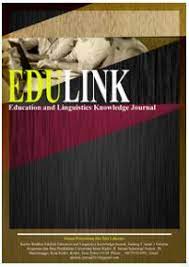An Analysis of English Jargon Used in MasterChef Indonesia Season 8
Abstract
This research aimed to know the jargon used in MasterChef Indonesia Season 8 which is broadcasted on tv namely RCTI. In this research, the researcher applied the descriptive qualitative method. The source of the data is the utterances in the conversation between the participants and the judges of MasterChef season 8 . The data of this research is taken from the utterances of the judges and the participants of Masterchef Indonesia season 8 which contains jargon. While the data source of this research is taken from the videos of Masterchef Indonesia on the Vision+ Website namely Visionplus.id. Vision+ is a digital live TV and Video On Demand (VOD) streaming media service owned by MNC Group. The researcher employed a free-of-conversation listening technique and the note-taking technique. This technique is carried out by observing the utterances used in the conversation between the three judges namely, Chef Arnold, Chef Juna, and Chef Renata, and the three participants namely, Adi, Jesselyn, and Nadya of MasterChef Indonesia Season 8 which contains Jargon. The result of this research found 25 jargon used in the conversation between judges and the participants of MasterChef Indonesia season 8. Of the 25 data, 18 jargon was in the form of words and 7 jargon in the form of phrases. This research found some functions of Jargon that were giving a person a sense of belonging to a specific group, making it easier for a person to communicate with their group, and as an effective signal for identification.
References
Allan, K., & Burridge, K. (2006). Forbidden words: Taboo and the censoring of language. Cambridge University Press.
Barber, A., & Stainton, R. J. (2010). Concise encyclopedia of philosophy of language and linguistics. Elsevier.
Brown, S., & Attardo, S. (2005). Understanding language structure, interaction, and variation: An introduction to applied linguistics and sociolinguistics for nonspecialists. University of Michigan Press ELT.
Coulmas, F. (2016). Language and Society. The Oxford Handbook of Language and Society, 17.
Crystal, D. (2011). A dictionary of linguistics and phonetics. John Wiley & Sons.
Djawa, Y. (2018). Analysis of the jargons used by players of the Clash-of-Clans game, an online game. Academic Journal of Education Sciences, 1(1), 28–39.
Fromkin, V., Rodman, R., & Hyams, N. (2018). An Introduction to Language (w/MLA9E Updates). Cengage Learning.
Halligan, N. (2004). An Introduction of Language Variety. Pearson Education Ltd.
Holmes, J., & Wilson, N. (2017). An introduction to sociolinguistics. Routledge.
Ives, P. (2004). Language and hegemony in Gramsci. Pluto Press London.
Lieber, R. (2021). Introducing morphology. Cambridge University Press.
Lilasari, L. N. T. (2022). An Analysis of Jargon Written on the Correspondence by Villas’ Staff in Gianyar, Bali. LACULTOUR: International Journal of Language and Cultural Tourism, 1(1), 1–7.
Malmkjær, K. (2009). The Routledge linguistics encyclopedia. Routledge.
Marshall, J. (2004). Language change and sociolinguistics: Rethinking social networks. Springer.
Morissan, M. A. (2010). Jurnalistik Televisi Mutakhir. Kencana.
Paramita, K. J. (2022). An Analysis of Jargons Used by the Staff of Food and Beverage Product at Nugra-ha Lovina Seaview Resort Singaraja. Innovative Education Journal, 1(1), 49–57.
Patton, M. Q. (2002). Qualitative research & evaluation methods. sage.
Pratama, P. R. (2021). An Analysis of The Use of Jargon In Online Game Point Blank.
Richards, J. C., & Schmidt, R. W. (2013). Longman dictionary of language teaching and applied linguistics. Routledge.
Rozakis, A. (2003). English grammar for the utterly confused. McGraw-Hill.
Saddhono, K. (2012). Pengantar Sosiolinguistik Teori dan Konsep Dasar. Surakarta: Program Buku Teks LPP UNS.
Shahidi, M. (2008). A Sociolinguistic Study of Language Shift in Mazandaran. Uppsala University.
Sudaryanto, S. (2015). Metode dan aneka teknik analisis bahasa. Yogyakarta: Appti.
Sugiyono, P. D. (2018). Quantitative, qualitative, and R&D research methods. Bandung:(ALFABETA, Ed.).
TeStrake, Y. (2000). The use of jargon in software requirements. University of Northern Iowa.
Wardhaugh, R. (2006). Sociolinguistics. Victoria: Blackwell Publishing.
Wardhaugh, R., & Fuller, J. M. (2021). An introduction to sociolinguistics. John Wiley & Sons.
Yule, G. (2020). The study of language (Fourth Edi). Cambridge university press.

This work is licensed under a Creative Commons Attribution 4.0 International License.
This work is licensed under a Creative Commons Attribution License























 This work is licensed under a
This work is licensed under a  https://orcid.org/0000-0001-9166-6040
https://orcid.org/0000-0001-9166-6040
